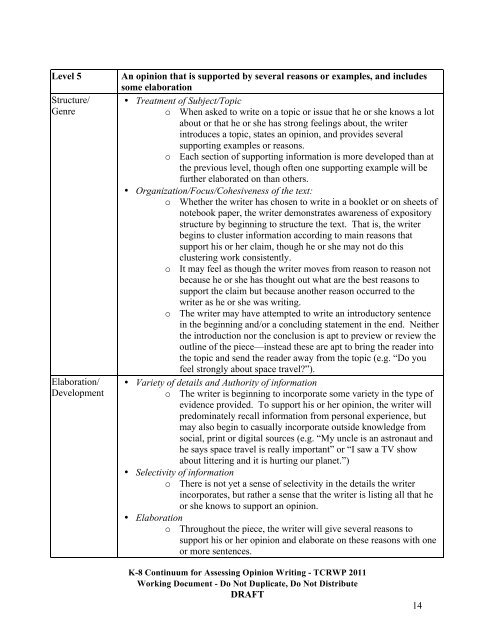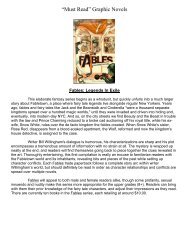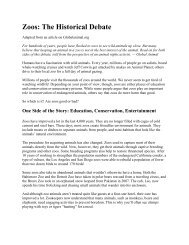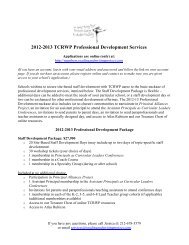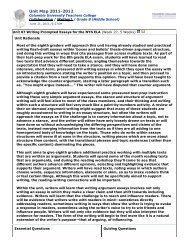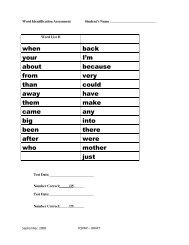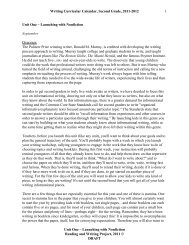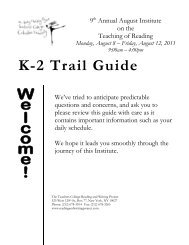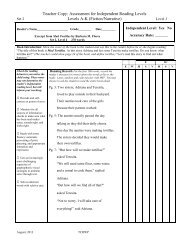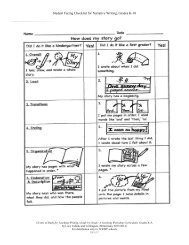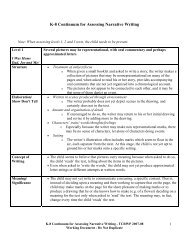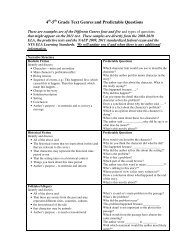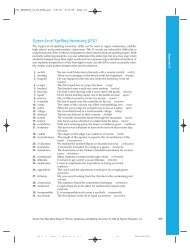Continuum for Assessing Opinion/Argument Writing - The Reading ...
Continuum for Assessing Opinion/Argument Writing - The Reading ...
Continuum for Assessing Opinion/Argument Writing - The Reading ...
Create successful ePaper yourself
Turn your PDF publications into a flip-book with our unique Google optimized e-Paper software.
Level 5<br />
Structure/<br />
Genre<br />
Elaboration/<br />
Development<br />
An opinion that is supported by several reasons or examples, and includes<br />
some elaboration<br />
• Treatment of Subject/Topic<br />
o When asked to write on a topic or issue that he or she knows a lot<br />
about or that he or she has strong feelings about, the writer<br />
introduces a topic, states an opinion, and provides several<br />
supporting examples or reasons.<br />
o Each section of supporting in<strong>for</strong>mation is more developed than at<br />
the previous level, though often one supporting example will be<br />
further elaborated on than others.<br />
• Organization/Focus/Cohesiveness of the text:<br />
o Whether the writer has chosen to write in a booklet or on sheets of<br />
notebook paper, the writer demonstrates awareness of expository<br />
structure by beginning to structure the text. That is, the writer<br />
begins to cluster in<strong>for</strong>mation according to main reasons that<br />
support his or her claim, though he or she may not do this<br />
clustering work consistently.<br />
o It may feel as though the writer moves from reason to reason not<br />
because he or she has thought out what are the best reasons to<br />
support the claim but because another reason occurred to the<br />
writer as he or she was writing.<br />
o <strong>The</strong> writer may have attempted to write an introductory sentence<br />
in the beginning and/or a concluding statement in the end. Neither<br />
the introduction nor the conclusion is apt to preview or review the<br />
outline of the piece—instead these are apt to bring the reader into<br />
the topic and send the reader away from the topic (e.g. “Do you<br />
feel strongly about space travel”).<br />
• Variety of details and Authority of in<strong>for</strong>mation<br />
o <strong>The</strong> writer is beginning to incorporate some variety in the type of<br />
evidence provided. To support his or her opinion, the writer will<br />
predominately recall in<strong>for</strong>mation from personal experience, but<br />
may also begin to casually incorporate outside knowledge from<br />
social, print or digital sources (e.g. “My uncle is an astronaut and<br />
he says space travel is really important” or “I saw a TV show<br />
about littering and it is hurting our planet.”)<br />
• Selectivity of in<strong>for</strong>mation<br />
o <strong>The</strong>re is not yet a sense of selectivity in the details the writer<br />
incorporates, but rather a sense that the writer is listing all that he<br />
or she knows to support an opinion.<br />
• Elaboration<br />
o Throughout the piece, the writer will give several reasons to<br />
support his or her opinion and elaborate on these reasons with one<br />
or more sentences.<br />
K-8 <strong>Continuum</strong> <strong>for</strong> <strong>Assessing</strong> <strong>Opinion</strong> <strong>Writing</strong> - TCRWP 2011<br />
Working Document - Do Not Duplicate, Do Not Distribute<br />
DRAFT<br />
14


